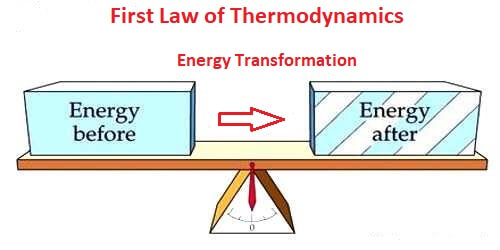First Law of ThermodynamicsFirst law of thermodynamics states that the total energy of an isolated system remains constant. It is also known as the conservation of energy, which states that energy cannot be created or destroyed but can be changed from one form into another form within an isolated system. 
According to this law, when a specific amount of heat is given to a system, the quantity of heat absorbed by the system is equal to the sum of the increase in the internal energy (change in internal energy) of the system and the external work done by the system. Or the change in internal energy is equal to the difference between the total heat supplied to the system and work done by the system. The first law of thermodynamics is represented by the following equation ΔU = ΔQ - ΔW Where, ΔU = Change in internal energy of the system ΔQ = Heat given to the system ΔW = Work done by the system. Therefore, the heat given to the system is; ΔQ = ΔU + ΔW First law of thermodynamics shows how the heat supplied to a system is related to the internal energy and the work done by the system. Most of the useful inventions are based on this law such as heat engines, refrigerators, and air conditioners. Let us take the example of a steam engine to understand the first law of thermodynamics. In a steam engine, the heat energy is transferred into mechanical energy. The water is heated which turns into steam which generates pressure to drive the piston within a cylinder that moves the engine. So, when the energy of one type disappears, an equal amount of another type of energy appears. A machine that will work without consuming energy cannot be created. Thermodynamic SystemIt refers to a part of the physical universe with a specific limit, which is under observation. This system can undergo internal transformations and exchange energy or mass with the external environment or surroundings. The boundary of the system separates it from its surroundings. What is an open system in Thermodynamics?In an open system, the transfer of both mass and energy occurs between the system and its surroundings. It means energy or mass can leave or enter the system. For example, a swimming pool is an open system as water can leave or enter it. What is a closed system in Thermodynamics?In a closed system, only transfer of energy occurs; transfer of mass does not occur. For example, a closed cylinder. It can be heated or cooled and it does not lose mass. But if open the cylinder it will behave like an open system. What is an isolated system in Thermodynamics?In an isolated system, neither exchange of energy nor exchange of mass occurs with the external environment. For example, the hot tea in the thermos flask or an insulated vessel is an isolated system as neither energy nor mass is exchanging with the surroundings. Sign Convention
Limitations of First law of thermodynamics
Applications of the first law of Thermodynamics1. Isothermal processInternal energy depends on temperature. If the temperature is constant, there will be no change in internal energy. For example, in an isothermal process temperature remains constant, so heat energy absorbed or given to the system is entirely used for doing work on the surroundings. dQ = dU + dW As dU =0 dQ = dW 2. Melting ProcessWhen a solid melts and changes into a liquid. Its internal energy increases. Amount of heat absorbed by the system = dQ Change is volume is nearly zero, so dV = 0 so, dW= 0 dQ = dU + dW dW = 0 So dQ = dU It shows, heat supplied is equal to the increase in the internal energy of the system. 3. Adiabatic ProcessExchange of heat does not occur in the adiabatic process, so dQ = 0 Now, according to the first law of thermodynamics; dQ = dU + dW - d U = dW So, work done by the system on the surroundings is by using the internal energy of the system. Or -dW = dU So, the increase in internal energy is due to the work done on the system by surroundings. 4. Isobaric ProcessPressure remains same in an isobaric process, so change in pressure (dP) = 0 So, work done by the system = W = - P dV Now, as per the first law of thermodynamics. dQ = dU - dW dU = dQ + dW An increase in internal energy of a system is due to the heat taken from the surroundings and if there is a decrease in internal energy, it would be due to the transfer of heat from the system to surroundings. |
 For Videos Join Our Youtube Channel: Join Now
For Videos Join Our Youtube Channel: Join Now
Feedback
- Send your Feedback to [email protected]
Help Others, Please Share









